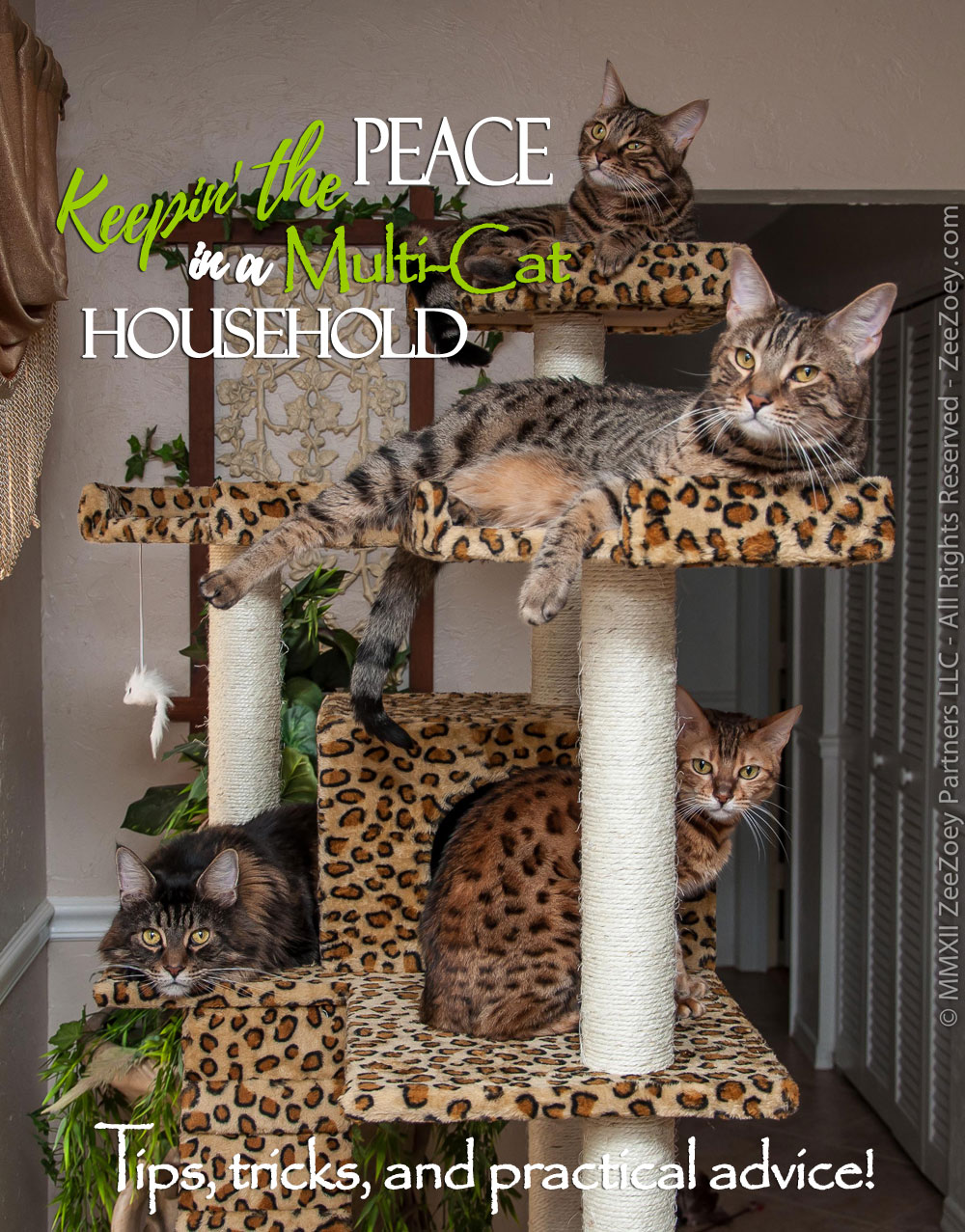Creating a harmonious environment for multiple cats under one roof is not just about avoiding hisses and scratches; it’s about understanding each feline friend’s unique needs and ensuring they’re met. It’s a balancing act that requires a mix of intuition, knowledge, and patience.
Key Takeaways
- Introduce cats slowly to foster acceptance and reduce stress.
- Ensure each cat has access to individual resources like food bowls and litter boxes.
- Provide vertical spaces for cats to escape and observe their surroundings.
- Address aggression promptly with separate spaces and reintroduce cats gradually.
- Encourage group play with appropriate toys to build positive interactions.
Tips for Fostering a Peaceful Multi-Cat Home
When it comes to fostering a peaceful multi-cat household, patience is your best friend. Introduce new cats gradually and give them time to adjust to their new surroundings and housemates. Remember, each cat is an individual with its own personality and needs.

“Peace in a Multi-Cat Household: Tips …” from zeezoey.com and used with no modifications.
Understanding Your Cats’ Social Habits
Cats are often misunderstood as solitary creatures, but in reality, they have complex social structures. Some cats enjoy the company of their fellow felines, while others prefer to keep to themselves. Observing your cats’ interactions can give you clues about their social preferences.
Example: If one cat is constantly hiding or avoiding another, they may feel intimidated or stressed. Providing separate spaces for each cat to eat, sleep, and play can help reduce tension.
Understanding these habits is crucial because it helps you tailor your approach to each cat’s comfort level, ensuring a smoother integration and less stress for everyone involved.
Resource Distribution to Minimize Conflict
Conflicts often arise in multi-cat households when cats feel they have to compete for resources. This can lead to stress, which may manifest as aggression or other behavioral issues.
Here’s what you need to do:
- Provide multiple food and water stations throughout your home to prevent competition and resource guarding.
- Ensure there are enough litter boxes – the general rule is one per cat, plus one extra.
- Offer various resting places and hideouts so each cat can have its own safe space.
By providing ample resources, you’re communicating to your cats that there’s no need to fight for survival, which can significantly reduce tension.
Structured Play to Nurture Positive Interactions
Playtime isn’t just fun and games; it’s a vital part of a cat’s life. It helps them exercise, relieves stress, and can even improve relationships between cats when done correctly.
Here’s how to encourage positive interactions and socialization tips for shy rescue greyhounds.
- Use toys that can be shared, like a string or laser pointer, to promote cooperative play.
- Supervise playtime to ensure it remains friendly, and separate cats if play escalates to aggression.
- Rotate toys to keep interest high and reduce boredom.
Structured play encourages cats to focus their energy on the activity rather than on each other, which can help build positive associations between them.
Optimized Sleeping Arrangements for Comfort and Security
Cats need a safe, comfortable place to rest and recharge. In a multi-cat home, it’s important to provide enough sleeping areas for each cat to have its own space.
Consider these tips:
- Provide a variety of beds in different locations – some cats like high perches, while others prefer cozy nooks.
- Use calming pheromone diffusers near sleeping areas to help reduce anxiety.
- Observe where each cat prefers to sleep and place beds in those areas to encourage use.
Respecting each cat’s sleeping preferences can greatly contribute to a peaceful household by reducing competition for prime sleeping spots.
Interventions for Immediate Peace
When tensions rise and the fur starts to fly, immediate action is essential to restore peace. If a scuffle breaks out, separate the cats gently but swiftly into different rooms. This gives them time to calm down and prevents further conflict.
It’s also beneficial to:
- Speak in a calm, soothing voice to help reduce the cats’ stress levels.
- Provide each cat with water, food, and a litter box in their separate spaces.
- Allow the cats to cool down for a few hours before attempting reintroduction.
These interventions can prevent a minor disagreement from turning into a long-term feud. For more detailed strategies, explore our guide on shelter cat wellness design.
Long-term Strategies to Reduce Friction
To prevent future conflicts, it’s crucial to understand the root of the problem. Is there competition over resources? Are territorial disputes at play? Once you identify the cause, you can implement long-term strategies to minimize friction.
For example, if you notice that conflicts occur around feeding times, you might consider:
- Feeding the cats in separate areas.
- Using puzzle feeders to slow down fast eaters and reduce food-related aggression.
- Creating a feeding schedule to establish routine and predictability.
Consistency and routine are key elements in maintaining a peaceful multi-cat household.
Catering Separate Resources for Harmony in a Multi-Cat Household
Each cat in your household should feel like they have their own space and resources. This reduces competition and helps each cat feel secure in their environment.
Essential Items Each Cat Needs
Imagine if you had to share your toothbrush with your entire family. Not appealing, right? Cats feel the same about their resources. Here’s what each cat should have:
- At least one food and water bowl – placing them in different locations can prevent bullying and stress during meal times.
- A litter box – the golden rule is one for each cat, plus one extra, placed in quiet, easily accessible locations.
- A bed or a comfortable resting place – cats need a safe spot to retreat and relax.
- Scratching posts or pads – these are crucial for claw maintenance and stress relief.
Ensuring each cat has its own set of resources can go a long way in fostering a peaceful coexistence.
Customizing Resources Based on Individual Cat Needs
Just like people, cats have individual preferences and needs. Pay attention to each cat’s behavior and adjust their environment accordingly. For example, a shy cat may prefer a covered litter box for privacy, while an older cat may need a litter box with lower sides for easy access.
Example: Luna, a senior cat, struggled to climb into the high-sided litter box. By providing a box with lower sides, she could use it without discomfort, reducing her stress and the likelihood of accidents outside the box.
Customizing resources to fit each cat’s needs shows them that they’re valued and understood, further promoting harmony.
Enriching Activities: Group Play for Your Cats
Group play is a fantastic way to build positive relationships between cats. It encourages them to associate each other with fun and pleasant experiences. Discover more about engaging play therapy techniques that can enhance group play for your cats.
Selecting the Right Toys for Collective Fun
Choosing the right toys is crucial for successful group play. Toys should be engaging and allow for shared play without forcing the cats into close contact, which could spark tension.
- Wand toys with feathers or strings are great because they can be controlled by you, keeping the cats at a safe distance from each other.
- Interactive toys that move unpredictably can captivate multiple cats at once, providing a shared focus.
- Large toys that can be batted around without being carried off by one cat ensure everyone gets a turn.
By carefully selecting toys that cater to group play, you’re setting the stage for a fun and conflict-free playtime.
Organizing Play Sessions for Social Cats
Some cats naturally enjoy the company of their peers, while others might need a little encouragement. Organizing play sessions can help more reserved cats build confidence and foster friendships within the group.
Here’s how to organize successful play sessions:
- Start with short, supervised sessions to gauge the cats’ reactions to each other and the toys.
- Encourage play with treats or catnip to create positive associations.
- Gradually increase the length of playtime as the cats become more comfortable with each other.
Remember, the goal is to create a fun and stress-free environment where all your cats can enjoy themselves.
Creating Perfect Cat Sleeping Arrangements
After a day of play and exploration, cats need a cozy place to rest. Creating ideal sleeping arrangements is crucial for a harmonious multi-cat home.
Personal Spaces for Each Cat
Every cat should have a space that they can call their own. This could be a bed, a cushion, or even a cardboard box. It’s important that this space is respected by the other cats and by humans too.
Here’s what you can do:
- Place beds in quiet areas where the cats can sleep without being disturbed.
- Use cat trees or shelves to provide vertical sleeping options for cats who prefer to be off the ground.
- Observe where each cat likes to sleep and place their personal bed there to encourage use.
Respecting a cat’s personal space helps them feel secure and less likely to act out due to stress or discomfort.
Warm and Safe Sleeping Locations
Cats are drawn to warm, cozy spots. Make sure the sleeping areas you provide are away from drafts and, if possible, in a spot where they can soak up some sunlight during the day. For more tips on keeping your feline friends happy and engaged, check out our guide on indoor cat stimulation.
Consider these extra touches:
- Heating pads designed for pets can provide warmth for older cats or those with joint issues.
- A blanket or a piece of your clothing with your scent can comfort cats who are particularly attached to you.
- Ensure there are enough options so that each cat can find their perfect spot without competition.
By creating a variety of inviting sleeping options, you’re helping to ensure that each cat feels safe, secure, and content.
Creating a harmonious environment for multiple cats under one roof is not just about avoiding hisses and scratches; it’s about understanding each feline friend’s unique needs and ensuring they’re met. It’s a balancing act that requires a mix of intuition, knowledge, and patience.
When it comes to fostering a peaceful multi-cat household, patience is your best friend. Introduce new cats gradually and give them time to adjust to their new surroundings and housemates. Remember, each cat is an individual with its own personality and needs.
Frequently Asked Questions
Even with all the right strategies in place, questions are bound to arise. Let’s address some of the most common queries about managing a multi-cat household.
How can I tell if my cats are playing or fighting?
Distinguishing between play and aggression can be tricky, but there are signs to look out for. Play is generally silent, with the cats taking turns chasing or being on top. Their claws are usually retracted, and their body language is relaxed. Fighting, on the other hand, often involves hissing, growling, and stiff body postures. If you notice any of these signs, it’s time to intervene and separate the cats to prevent injury.
What should I do if my cats are fighting over food?
If your cats are fighting over food, it’s important to create separate feeding stations. Place these stations out of sight from each other to reduce tension. You can also try feeding the cats at different times or in different rooms. If one cat is a bully, you might need to supervise meal times to ensure each cat gets their fair share.
It’s essential to monitor the situation closely and make adjustments as needed. Remember, consistency and fairness are key to reducing food-related aggression.
How many litter boxes do I need for multiple cats?
The general rule of thumb is to have one litter box per cat, plus one extra. So, if you have three cats, you should have four litter boxes. This helps to prevent any one cat from blocking access to the boxes and reduces the likelihood of inappropriate elimination behaviors. Place the litter boxes in different locations around your home to give your cats options and privacy. For more tips on indoor cat stimulation, check out our resources.
Is it okay to keep all my cats’ beds in one room?
While it’s okay to have multiple beds in one room, it’s also important to spread them out across different areas of your home. Cats need their own space and might feel crowded if all the beds are in one room. Some cats may prefer a quiet corner in a different room or a sunny spot in the living room. Pay attention to where each cat likes to rest and provide beds in those areas.
Can group playtime help reduce territorial behavior in cats?
Yes, group playtime can be an effective way to reduce territorial behavior by redirecting your cats’ energy towards positive interactions. When cats engage in play together, they learn to share space and associate their housemates with fun rather than competition. Use toys that encourage shared activity, like a feather wand or a ball track, and always supervise playtime to ensure it stays friendly.
Remember, creating a harmonious multi-cat household takes time and effort. But with patience, observation, and the right strategies, you can cultivate a peaceful and happy home for all your feline family members.


